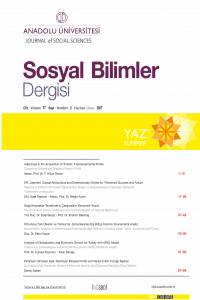Abstract
Ekonomiler, sürdürülebilir ekonomik büyüme ve gelişmelerini gerçekleştirebilmek için, ödemeler dengesi açıklarına dikkat etmek durumundadırlar. Bir ülkenin cari işlemler açıkları bakımından risk taşıması, cari ekonomi politikasının hali hazırda ve gelecekte sürdürülebilirlik noktasında sorunlu olduğunun göstergesi olarak değerlendirilebilir. Cari işlemler açığının sürdürülebilirliği, zamanlararası bütçe kısıtına bağlı olarak tanımlanmaktadır. Söz konusu dış bütçe kısıtına göre, dış dünyadan elde edilen gelirler ile dış âleme yapılan ödemelerin izleyeceği yol, zamanlararası geri ödeme yeteneği koşulunu belirlemektedir. Eğer bu iki değişken arasında uzun dönem denge ilişkisi mevcut değilse, zamanlararası bütçe kısıtı sağlanmaz. Bu çalışmanın amacı, 2005Q1-2014Q4 dönemi için Orta Asya Türk Ülkeleri ve Türkiye’nin zamanlararası geri ödeme yeteneği koşulunu sağlayıp sağlamadığını belirlemektir. Bu çalışmada, söz konusu Avrasya ekonomilerinin cari işlemler dengesi açısından potansiyel risk taşıyıp taşımadığı incelenmiştir.
References
- Ahmed, S., Rogers, J. H. (1995). Government Budget Deficits and Trade Deficits Are Present Value Constraints Satisfied in Long-Term Data?. Journal of Monetary Economics, 36(2), 351-374.
- Azgun, S. (2009). Is Current Account Deficit ‘Too Large’: Some Further Evidence. Trakia Journal of Sciences, 7(3), 51-56.
- Baglioni, A., Cherubini, U. (1993). Intertemporal Budget Constraints and Public Debt Sustainability: The case of Italy. Applied Econometrics, 25(2), 275-283.
- Binatlı, A.O., Sohrabji, N.(2012). Intertemporal Solvency of Turkey’s Current Account. Panoeconomicus, 59(1), 89-104.
- Bohn, H. (1998). The Behavior of U.S. Deficits Public Debt and Deficits. Quarterly Journal of Economics, 113 (3), 949-963.
- Caparole, M. G. (1995). Bubble Finance and Debt Sustainability: a Test of the Government’s Intertemporal Budget Constraint. Applied Econometrics, 27(12), 1135-1143.
- Hakkio, C. S., Rush, M. (1991). Is the Budget Deficit ‘Too Large?. Economic Inquiry, 29(3), 429-445.
- Hamilton, J. D., Flavin, M. A. (1986). On the Limitations of Government Borrowing: A Framework for Empirical Testing . The American Economic Review, 76(4), 808-819.
- Pesaran, M. H., Shin, Y. Smith, R. J.(2001). Bounds Testıng Approaches To The Analysis of Level Relatıonshıps. Journal of Applied Econometrıcs, 16(3), 289-326.
- Quintos, C. E. (1995). Sustainability of Deficit Process with Structural Shifts. Journal of Business & Economic Statistics, 13(4), 409- 417.
- Tanner, E., Liu P. (1994). The Budget Deficit ‘Too Large’ Some Further Evidence. Economic Inquiry, 32(3), 511-518.
- Trehan, B., C. E. Walsh (1991). Testing Intertemporal Budget Constraints: Theory and Applications to U.S. Federal Budget and Current Account Deficits. Journal of Money, Credit and Banking, 23(2), 206-223.
- Wickens, M.R., Uctum M. (1993). The Sustainability of Current Account Deficits: A Test of The U.S. Intertemporal Budget Constraint. Journal of Economic Dynamic and Control, 17(3), 423-441.
- Wilcox, D. W. (1989). The Sustainability of Government Deficits: Implications of the Present-Value Borrowing Constraint. Journal of Money, Credit and Banking, 21(3), 291-306.
Abstract
References
- Ahmed, S., Rogers, J. H. (1995). Government Budget Deficits and Trade Deficits Are Present Value Constraints Satisfied in Long-Term Data?. Journal of Monetary Economics, 36(2), 351-374.
- Azgun, S. (2009). Is Current Account Deficit ‘Too Large’: Some Further Evidence. Trakia Journal of Sciences, 7(3), 51-56.
- Baglioni, A., Cherubini, U. (1993). Intertemporal Budget Constraints and Public Debt Sustainability: The case of Italy. Applied Econometrics, 25(2), 275-283.
- Binatlı, A.O., Sohrabji, N.(2012). Intertemporal Solvency of Turkey’s Current Account. Panoeconomicus, 59(1), 89-104.
- Bohn, H. (1998). The Behavior of U.S. Deficits Public Debt and Deficits. Quarterly Journal of Economics, 113 (3), 949-963.
- Caparole, M. G. (1995). Bubble Finance and Debt Sustainability: a Test of the Government’s Intertemporal Budget Constraint. Applied Econometrics, 27(12), 1135-1143.
- Hakkio, C. S., Rush, M. (1991). Is the Budget Deficit ‘Too Large?. Economic Inquiry, 29(3), 429-445.
- Hamilton, J. D., Flavin, M. A. (1986). On the Limitations of Government Borrowing: A Framework for Empirical Testing . The American Economic Review, 76(4), 808-819.
- Pesaran, M. H., Shin, Y. Smith, R. J.(2001). Bounds Testıng Approaches To The Analysis of Level Relatıonshıps. Journal of Applied Econometrıcs, 16(3), 289-326.
- Quintos, C. E. (1995). Sustainability of Deficit Process with Structural Shifts. Journal of Business & Economic Statistics, 13(4), 409- 417.
- Tanner, E., Liu P. (1994). The Budget Deficit ‘Too Large’ Some Further Evidence. Economic Inquiry, 32(3), 511-518.
- Trehan, B., C. E. Walsh (1991). Testing Intertemporal Budget Constraints: Theory and Applications to U.S. Federal Budget and Current Account Deficits. Journal of Money, Credit and Banking, 23(2), 206-223.
- Wickens, M.R., Uctum M. (1993). The Sustainability of Current Account Deficits: A Test of The U.S. Intertemporal Budget Constraint. Journal of Economic Dynamic and Control, 17(3), 423-441.
- Wilcox, D. W. (1989). The Sustainability of Government Deficits: Implications of the Present-Value Borrowing Constraint. Journal of Money, Credit and Banking, 21(3), 291-306.
Details
| Primary Language | Turkish |
|---|---|
| Journal Section | Articles |
| Authors | |
| Publication Date | June 15, 2017 |
| Submission Date | June 1, 2016 |
| Published in Issue | Year 2017 Volume: 17 Issue: 2 |
This work is licensed under Creative Commons Attribution-NonCommercial 4.0 International License.


